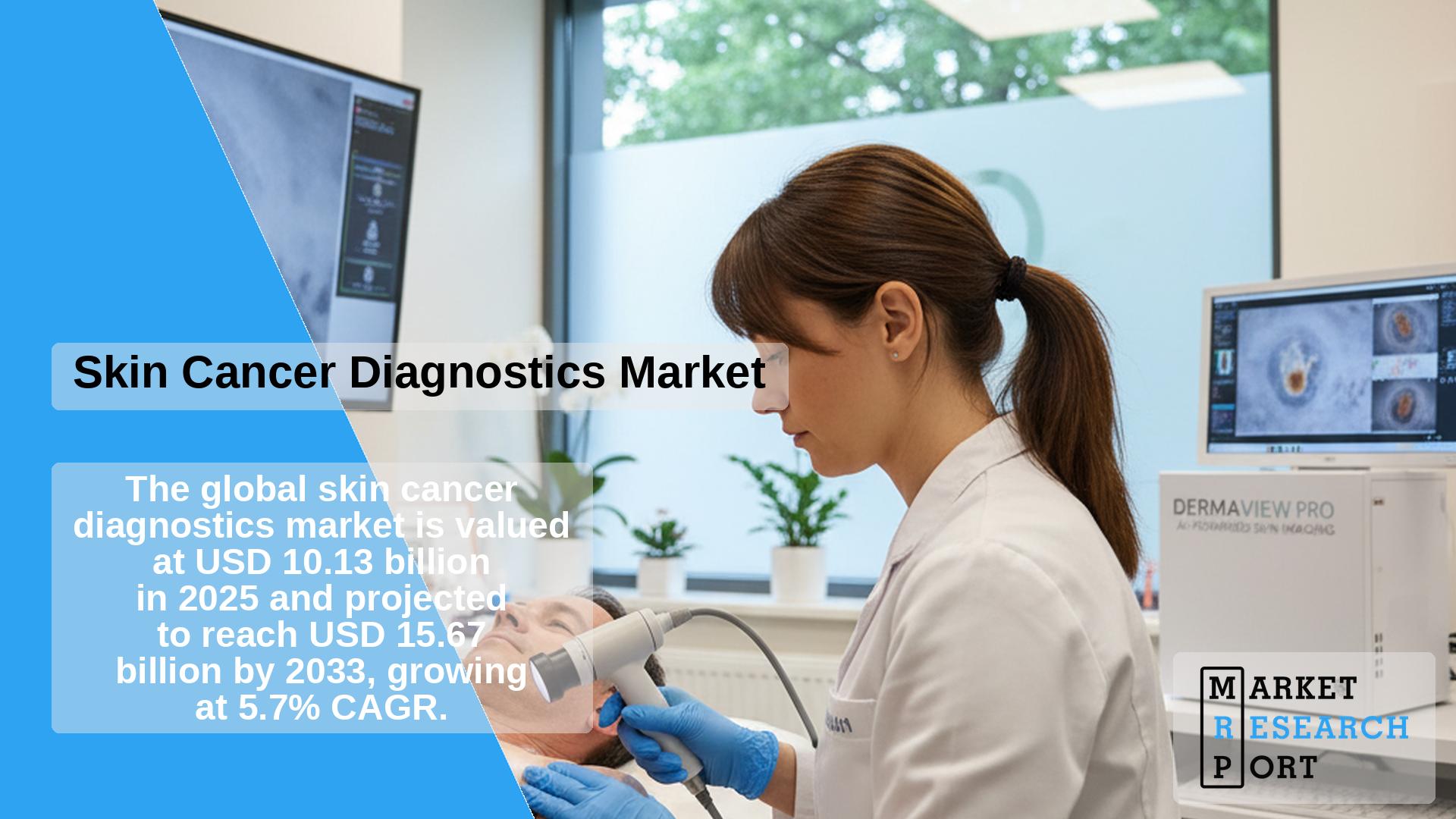
The global skin cancer diagnostics market was valued at approximately USD 10.07 billion in 2025 and is predicted to grow to USD 15.67 billion by 2033, exhibiting a compound annual growth rate (CAGR) of 5.7% during 2025 to 2033. Growth is driven by advancements in technology, increasing integration of artificial intelligence (AI) in diagnostics, and a rising patient preference for non-invasive diagnostic methods.
Increased awareness campaigns, government initiatives promoting early detection, and the rising incidence of skin cancer, particularly in sun-exposed regions, are key growth factors. Collaborative efforts between healthcare providers and tech firms are enhancing diagnostic accuracy and accessibility.
Technological innovations such as AI-powered devices, including the FDA-approved DermaSensor launched in 2024, use advanced spectroscopy and machine learning to detect skin cancer types accurately and non-invasively. AI applications in diagnostic imaging mitigate subjective interpretation and improve access to expert assessment, reducing delay in diagnosis and unnecessary biopsies.
AI is widely employed in tools such as total body photography and dermoscopy to allow early and precise detection. Market-approved AI software integrated with specialized hardware demonstrates improved diagnostic capabilities in clinical trials. Reflectance Confocal Microscopy (RCM) and Optical Coherence Tomography (OCT) are also gaining prominence as non-invasive modalities effective in skin cancer management.
The industry is characterized by a high innovation rate, incorporating AI, machine learning, and molecular diagnostic techniques. Recent milestones include the approval of AI-based diagnostic solutions like South Korea’s canofyMD SCAI and collaboration projects enhancing medical AI development across multiple hospitals. Mergers and acquisitions are frequent, exemplified by FotoFinder Systems’ acquisition of DermLite enhancing dermoscopy device offerings.
Regulatory pathways such as FDA’s expanded 510(k) approval mechanism ensure safety and efficacy, while the biopsy remains the essential diagnostic benchmark with no true substitutes.
The majority of diagnoses involve non-melanoma skin cancers; basal cell carcinoma and squamous cell carcinoma constitute almost 90% of malignant skin tumors. Deep learning techniques hold promise in improving diagnostic sensitivity and specificity comparable to experts, especially for NMSC.
Melanoma is the fastest-growing segment due to increased UV exposure and rising public awareness, driving innovation in diagnostics and treatment, including immunotherapies and targeted treatments.
Skin biopsy dominates as the principal diagnostic approach, with novel tests such as the Syn-One Test gaining traction due to regulatory designations. Emerging imaging technologies including RCM, OCT, MRI, NIR bioimaging, and PET facilitate non-invasive detection and treatment planning with dynamic monitoring capabilities.
Hospitals and clinics lead the market given their extensive infrastructure and high patient volumes, further accelerated by integration of AI and teledermatology to enhance diagnostic accuracy and accessibility. Teledermatology initiatives, increasingly adopted by the NHS and health systems worldwide, have significantly reduced unnecessary visits and expedited care.
| Attribute | Details |
|---|---|
| Market Size (2025) | USD 10.07 billion |
| Revenue Forecast (2033) | USD 15.67 billion |
| Growth Rate (CAGR 2025-2033) | 5.7% |
| Historical Data | 2021–2024 |
| Forecast Period | 2025–2033 |
| Segments Included | Cancer type, test type, end use, region |
| Regions Covered | North America, Europe, Asia Pacific, Latin America, Middle East & Africa |
| Countries Included | U.S., Canada, Germany, UK, France, Italy, Spain, Denmark, Sweden, Norway, China, Japan, India, South Korea, Australia, Brazil, Mexico, Argentina, South Africa, Saudi Arabia, UAE, Kuwait |
What is the current size of the skin cancer diagnostics market?
The market was valued at around USD 10.07 billion in 2025.
What is the anticipated market growth?
The industry is forecasted to grow at a 5.7% CAGR, reaching USD 15.67 billion by 2033.
Which cancer type dominates the market?
Non-melanoma skin cancers hold the largest share due to high prevalence of basal and squamous cell carcinomas.
What are the leading test types?
Skin biopsy remains the primary diagnostic method, alongside growing adoption of dermatoscopy and advanced imaging techniques.
Who are the principal market players?
Key participants include Castle Bioscience, DermTech, bioMérieux, Foundation Medicine, DermaSensor, Roche, and Quest Diagnostics.